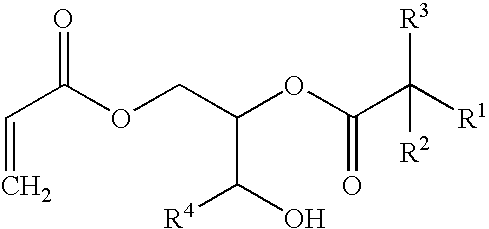Radiation curable inks
a curable ink and radiation technology, applied in the field of hybrid radiation curable ink, can solve the problems of unsuitability for inkjet ink, difficult adhesion of uv curable inkjet ink to glass, pet and metal substrates,
- Summary
- Abstract
- Description
- Claims
- Application Information
AI Technical Summary
Benefits of technology
Problems solved by technology
Method used
Image
Examples
example 1
[0095]Ink compositions of the invention, based upon di-functional epoxies, are provided in Table 1.
TABLE 1Inks Based on Di-functional Epoxies.Raw material1A1B1C1D1E1F1G1H1JIrgastab UV100.02Byk361N0.050.050.050.030.050.05Byk3770.0250.0250.05Byk088Byk 080A0.500.050.050.090.0250.054-methoxyphenol0.050.050.050.040.0250.050.0250.0250.05UVACURE150021.4524.7524.4UVACURE16004.003.544Esacure ITX (SR1.501.21.211124)Heloxy 6860.0043.3547.652.1554.6843.35261820ACE monomer17.40151514.2515159915Genocure MBF4.00554.4955444SR25696Irgacure 819(CIBA)10.5Onmicat BL550161317.821618propylene carbonate888887cyan dispersion 112.5012.512.5Yellow dispersion 112.5Black dispersion 111.25magenta dispersion 112.511.13White dispersion 124.000024Total100.000100.000100.000100.000100.000100.000100.000100.000100.000
example 2
[0096]Ink compositions of invention, based upon mono-functional and poly-functional monomers, are provided in Table 2.
TABLE 2Inks Based on Mono-functional and Poly-functional Monomers.Raw Material2A2BByk377114-methoxyphenol0.0250.025Esacure ITX (SR 1124)11UVACURE160044ACE24.4750Genocure MBF55Heloxy 483136Heloxy 71425.475Propylene carbonate77Boltorn H 20048Cyan Dispersion 2magenta dispersion 212.5yellow dispersion 212.5Total100.000100.000
example 3
[0097]An ink composition of the invention, based upon mono-functional and poly-functional monomers, is also provided in Table 3.
TABLE 3Inks Based on Mono-functional and Poly-functional Monomers.Raw Material3ACD42028CN13110Esacure ITX (SR 1124)1UVACURE16004Neodene 16 (1-hexadecene)2Genocure MBF4CN966J754Irgacure 8191Lucirin TPO3SR50615Ebecryl 13604Heloxy 485Heloxy 76black dispersion 213Total100.00
PUM
| Property | Measurement | Unit |
|---|---|---|
| jetting frequency | aaaaa | aaaaa |
| jetting frequency | aaaaa | aaaaa |
| elongation | aaaaa | aaaaa |
Abstract
Description
Claims
Application Information
 Login to View More
Login to View More - R&D
- Intellectual Property
- Life Sciences
- Materials
- Tech Scout
- Unparalleled Data Quality
- Higher Quality Content
- 60% Fewer Hallucinations
Browse by: Latest US Patents, China's latest patents, Technical Efficacy Thesaurus, Application Domain, Technology Topic, Popular Technical Reports.
© 2025 PatSnap. All rights reserved.Legal|Privacy policy|Modern Slavery Act Transparency Statement|Sitemap|About US| Contact US: help@patsnap.com


